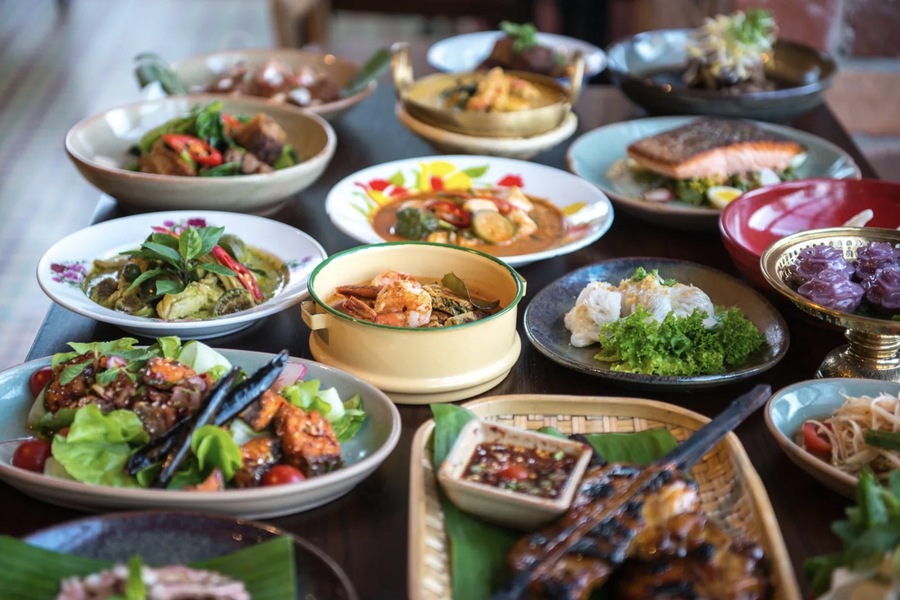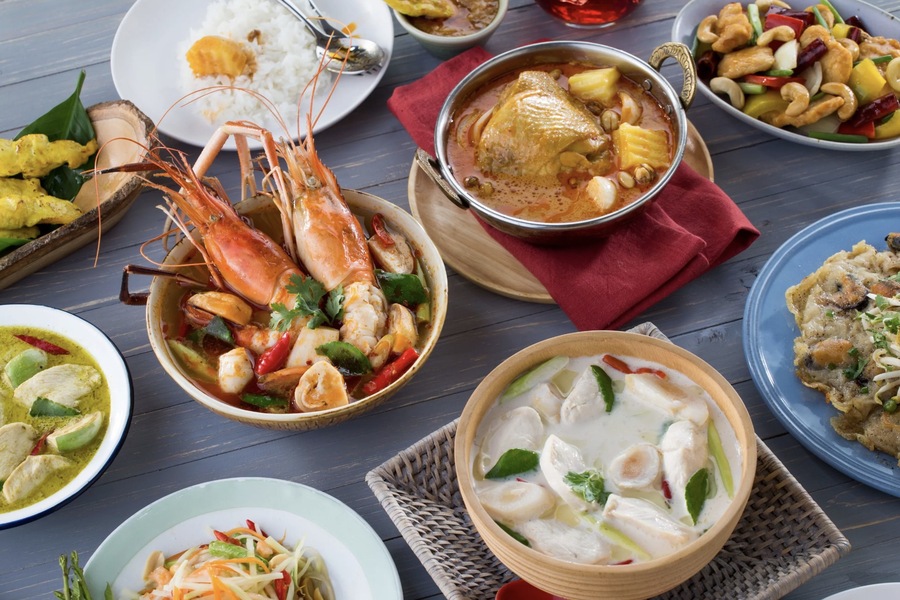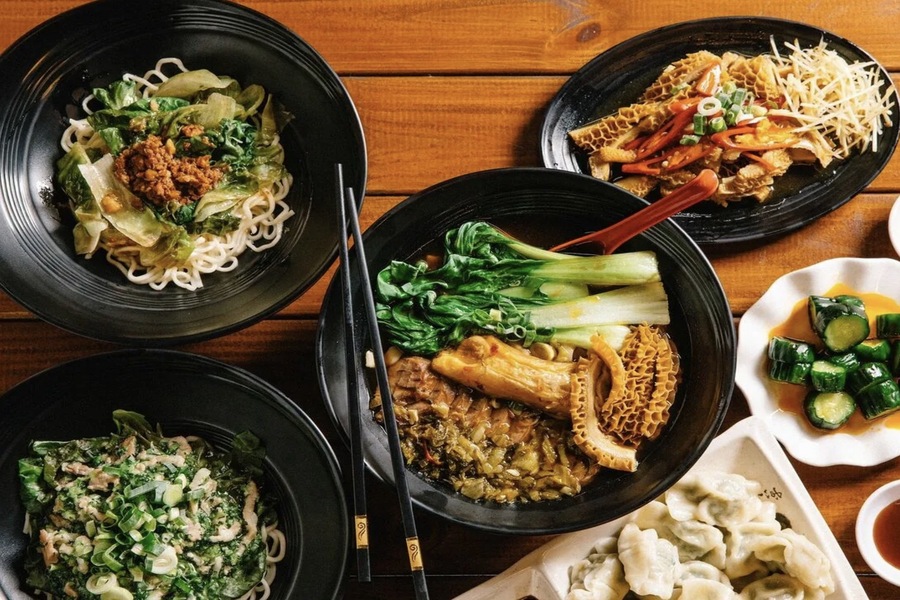Asian cuisine is a culinary treasure trove that spans vast geographical regions, offering a unique blend of flavors, cooking techniques, and cultural significance. The term “Asian cuisine” generally refers to the collective culinary traditions of East, South, and Southeast Asia. It’s a cuisine defined by its use of staple ingredients like rice and noodles, vibrant seasonings, an emphasis on balance, and cooking methods that prioritize freshness and nutrition. From the aromatic curries of Thailand to the delicate sushi rolls of Japan, Asian cuisine is a celebration of diversity and flavor, where salty, sweet, sour, and spicy tastes harmoniously coexist in a single dish. This article explores the essential elements, health benefits, regional variations, iconic dishes, and interesting culinary facts that make Asian cuisine a global favorite. Guide bar will be your assistant in choosing the best establishment with Asian cuisine.
Essential Elements of Asian Cuisine
A core characteristic of Asian cuisine is its reliance on key ingredients and cooking methods that highlight the natural flavors of fresh produce, seafood, and grains. Rice and noodles, two ubiquitous staples, are often the base of many dishes, with various accompaniments such as vegetables, meats, and seafood added to create a satisfying and balanced meal. The real magic, however, lies in the seasonings and sauces that elevate these dishes.
- Seasonings and Sauces
The careful use of seasonings is what gives Asian dishes their signature taste. Soy sauce, rich in umami, serves as the foundation for many recipes, delivering a salty depth of flavor. Soy products, such as tofu, are commonly used not just as seasonings but as versatile sources of protein in dishes. Garlic and ginger are frequently used to enhance the aroma and provide an extra layer of flavor, while sesame oil imparts a nutty richness. Fish sauce is another key seasoning, especially in Southeast Asian cuisines, where it adds a piquant and savory dimension. - Balance of Flavors
Asian cuisine is particularly known for its masterful balance of contrasting flavors. Whether it’s the combination of salty soy sauce with the sweetness of palm sugar or the contrast between the sourness of lime and the heat of chili peppers, every dish aims to create a satisfying harmony of taste sensations. - Cooking Techniques
While Asian cuisine includes a variety of cooking methods, one of the most popular is stir-frying. This method involves cooking ingredients quickly over high heat in a small amount of oil, ensuring that the vegetables and proteins remain crisp and flavorful. Steaming and boiling are also widely used, especially in countries like China and Japan, where these techniques are employed to preserve the nutrients and natural flavor of the ingredients. - Freshness and Nutritional Value
Fresh vegetables, seafood, and herbs play an essential role in Asian cooking. These ingredients are often minimally processed and lightly cooked to retain their nutritional value. This focus on fresh, wholesome food is a significant reason why Asian cuisine is considered one of the healthiest in the world.

Regional Variations in Asian Cuisine
The culinary landscape of Asia is as diverse as its geography, with each region offering a distinctive approach to cooking. From the minimalistic elegance of Japanese cuisine to the hearty, meat-centric dishes of Central Asia, the variety is immense.
Japanese Cuisine
Japan is renowned for its precision and attention to detail in cooking. Japanese cuisine emphasizes seasonality and presentation, with dishes like sushi, sashimi, and tempura reflecting the country’s appreciation for fresh ingredients and subtle flavors. Rice and seafood dominate the Japanese table, and the cuisine is characterized by its lightness and balance, making it one of the healthiest culinary traditions in the world.
Chinese Cuisine
China’s culinary tradition is vast, with each region offering its own unique flavors. In the Sichuan province, for example, the food is bold and spicy, often featuring the famous Sichuan peppercorn that provides both heat and a numbing sensation. Cantonese cuisine, on the other hand, is known for its mild flavors and emphasis on seafood. In northern China, noodles and dumplings are staples, reflecting the colder climate and the reliance on wheat-based foods. Chinese cuisine places a significant emphasis on texture, whether it’s the crunch of stir-fried vegetables or the tender bite of perfectly cooked dumplings.
Korean Cuisine
Korean food is deeply rooted in its cultural history, with dishes like kimchi (fermented vegetables) showcasing the country’s love for bold, fermented flavors. Korean cuisine is also known for its barbecued meats (such as bulgogi and galbi), often marinated in a mixture of soy sauce, garlic, and sesame oil, then grilled to perfection. Communal dining is central to Korean culture, with meals often served family-style, accompanied by a wide array of side dishes known as banchan.
Thai Cuisine
Thai food is famous for its intricate balance of sweet, salty, sour, and spicy flavors. Dishes like Tom Yum (a hot and sour soup) and Pad Thai (stir-fried noodles) exemplify the country’s culinary philosophy of combining seemingly contrasting flavors into a harmonious whole. Thai cuisine also incorporates a wide range of fresh herbs and aromatic spices, such as lemongrass, kaffir lime leaves, and Thai basil.
Vietnamese Cuisine
Vietnam’s culinary tradition is all about freshness and simplicity. Dishes like Pho (a fragrant beef noodle soup) and Banh Mi (a French-inspired sandwich) are iconic examples of how Vietnamese chefs combine simple ingredients to create complex flavors. Fresh herbs, rice noodles, and fish sauce are staples, and the cuisine’s reliance on fresh vegetables and lean proteins makes it one of the healthiest in Asia.
Central Asian Cuisine
The hearty dishes of Central Asia reflect the region’s nomadic traditions. Kazakh cuisine, for example, is centered around meats like lamb, mutton, and beef, often cooked in stews or grilled. Breads like flatbreads and dumplings are also commonly served, and dairy products, such as fermented mare’s milk, play a significant role in the region’s diet.
Health Benefits of Asian Cuisine
Asian cuisine is not only delicious but also offers numerous health benefits, thanks to its focus on fresh ingredients and balanced meals.
Vegetable-Rich Diet
Many Asian dishes are based on vegetables, providing essential vitamins, minerals, and dietary fiber, which contribute to healthy digestion and overall wellness.
Legumes and Plant-Based Proteins
Soybeans, chickpeas, and beans are prominent in Asian cooking, offering plant-based protein alternatives that are lower in saturated fats compared to animal proteins. Tofu, made from soybeans, is a particularly versatile ingredient used in stir-fries, soups, and salads.
Low-Calorie, Nutrient-Dense Meals
Many soups and salads in Asian cuisine are light yet filling, providing a satisfying meal without excess calories. Dishes like Vietnamese Pho or Japanese miso soup are rich in nutrients but relatively low in calories.
Spices and Herbs for Metabolism
Many spices used in Asian cuisine, such as ginger, turmeric, and chili peppers, have been shown to boost metabolism and aid digestion. These ingredients also possess anti-inflammatory properties, making them a natural addition to a health-conscious diet.
Healthy Carbohydrates
Rice, particularly brown rice, is a staple in many Asian dishes and serves as a healthier alternative to more processed carbohydrates. Brown rice is rich in fiber and has a lower glycemic index than white rice, making it a better choice for those managing blood sugar levels.
Iconic Dishes of Asian Cuisine
Asian cuisine boasts an impressive variety of dishes, each region offering its own specialties that have captured the hearts of food lovers worldwide.
- Tom Yum (Thailand)
A hot and sour soup made with shrimp, mushrooms, and a fragrant broth infused with lemongrass, lime, and chili paste. This dish perfectly balances the fiery heat of the chili with the refreshing tang of citrus. - Pho Bo (Vietnam)
A popular Vietnamese soup made with beef, rice noodles, and aromatic herbs. It is typically served with lime, fresh basil, and bean sprouts, allowing diners to customize their bowls to their liking. - Pad Thai (Thailand)
Stir-fried rice noodles with shrimp, peanuts, and a flavorful tamarind-based sauce. This dish has become a favorite worldwide for its sweet, savory, and slightly tangy taste. - Kung Pao Chicken (China)
A stir-fried dish from Sichuan province made with diced chicken, peanuts, and chili peppers. The combination of spicy and savory flavors makes it a staple in Chinese cuisine. - Udon Noodles (Japan)
Thick, chewy wheat noodles served in a variety of broths or stir-fried with seafood, vegetables, and soy sauce. Udon is a comforting, hearty dish enjoyed across Japan. - Laksa (Malaysia)
A spicy noodle soup made with a rich coconut milk-based broth, flavored with shrimp or chicken. Laksa’s creamy, spicy texture has made it one of Southeast Asia’s most beloved dishes. - Momo (Himalayas)
Steamed dumplings filled with meat or vegetables, often served with a side of soup or chili sauce. Momo is a popular dish in Nepal, Tibet, and Bhutan, reflecting the region’s preference for hearty, comforting foods.

Fascinating Facts About Asian Cuisine
Soup After Meals in China
In China, it is common to serve soup after the main meal, as it is believed to aid digestion and promote better metabolism.
Pink Noodles in Thailand
In Thailand, you can find pink noodles called “yen ta fo.” Their bright color comes from fermented soybean paste, which also gives the dish a slightly sweet flavor.
Noodles as a Symbol of Longevity
In many Asian cultures, noodles symbolize long life and prosperity.
For this reason, they are often served uncut during New Year’s celebrations or birthday parties.
Conclusion
Asian cuisine is a rich and diverse culinary tradition that offers something for everyone. Its emphasis on fresh ingredients, balanced flavors, and unique cooking techniques has made it one of the most popular and influential cuisines worldwide. Whether you’re enjoying the bold flavors of Sichuan cuisine, the delicate nuances of Japanese sushi, or the aromatic spices of Thai dishes, Asian cuisine provides an unforgettable culinary experience. With its blend of health benefits and extraordinary flavors, it’s no wonder that Asian cuisine continues to capture the hearts and taste buds of people across the globe.

Surfer, foodie, record lover, Swiss design-head and ADC member. Performing at the sweet spot between simplicity and elegance to create not just a logo, but a feeling. Let’s chat.


